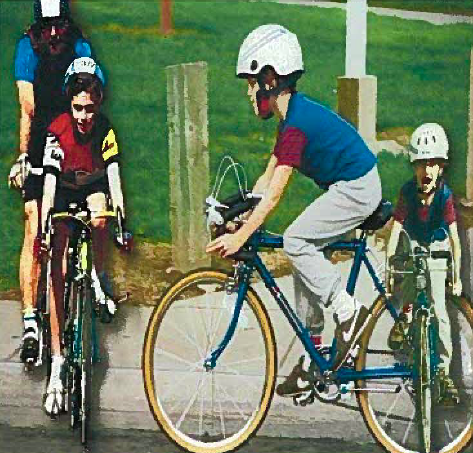Caltrans Report Celebrates Its Support of Active Transportation
3:47 PM PST on February 26, 2015

Caltrans, the California Department of Transportation, just released its annual report to the legislature [PDF] on its achievements last year in the area of “non-motorized travel,” and this year the document is more celebratory than it has been in the past.
With good reason. It shows a new side of Caltrans, starting with its cover. Instead of a blurry, weirdly stretched-out photograph of bicycle riders, as on previous reports, this year's edition features Caltrans Executive Director Malcolm Dougherty standing with his bicycle—and looking like he knows how to ride it.
This new, bike-friendly tone at Caltrans is a welcome change from the past, when the department was focused on moving cars, and it's in keeping with other efforts it has been making in the last year. When a report from the State Smart Transportation Initiative thoroughly drubbed the department for being risk-averse and dysfunctional, its leaders responded by reworking its mission statement, endorsing the principal of more flexible street design guidelines, and creating a new position of Director of Sustainability.
These achievements are celebrated front and center in the new report.
“We are taking a different look at transportation,” said Director Dougherty. “It's a change in perspective. Before, we saw the need to solve car-oriented transportation problems. Now, we see that there are transportation problems that need to be solved, and multimodal needs have to be considered in those solutions.”

Just saying the department has a new focus, however, isn't going to change a thing. Dougherty has been traveling the state, meeting with Caltrans district staff to discuss the new mission, its accompanying vision statement, and the objectives and goals that are being developed to go with them. “A fair amount of our employees were already sensitive to and incorporating bicycle and pedestrian concerns into their planning,” he said, “and some of them have stated that they're glad we're going in this direction.”
Caltrans still has a long way to go to become a truly multimodal state transportation department. Renaming the report would be a start. "Non-motorized transportation" smacks of Old Engineer Speak, and describing bicycling and walking that way is a little like calling women "nonmen." Nevertheless, the 2013-2014 Non-Motorized Transportation Facilities report does highlight some real achievements.
For example, endorsing the NACTO Urban Street Design Guidelines was a huge change. Or, at least, the beginning of one. The design guidelines are not yet incorporated into the Highway Design Manual, Caltrans' “bible” of design standards that has previously been used to clobber new design ideas to death. But the NACTO endorsement does give local planners a wider range of transportation solutions to consider than they have had.
Something not mentioned in the report, but which should have been, was the inclusion of several new design standards in the California Manual on Uniform Control Devices. Standards for buffered bike lanes, contra-flow bike lanes, and recommendations for marking bike lanes through intersections were all added to the manual for its biannual update in December, making them readily available for planners throughout the state to use.
The report also celebrates California's jump from 19th to 9th place in the League of American Bicyclist's ranking of bicycle-friendly states. For this achievement, Caltrans credits the creation of the Active Transportation Program (ATP), which combined funding from a variety of sources into one program to encourage walking and bicycling, and the Three Feet for Safety Act (A.B. 1371), which went into effect last fall.
The League helpfully offered recommendations on how the state can improve its “bicycle friendly” rating further, and some of the tasks are definitely under the purview of Caltrans. For example, California currently lacks a statewide bicycle plan. Not mentioned in the report is that, according to Caltrans Public Information Officer Mark Dinger, the department expects to start work on a statewide bicycle and pedestrian plan this coming June.
The report highlights several projects completed in the last year, including a paved, off-street bike path in San Luis Obispo, the first Bicycle Boulevard in Los Angeles County (along Marengo Avenue in Pasadena), the Willow Avenue Trail in Fresno, and the Oak Manor Trail in Ukiah.
Two noteworthy things about these projects jump out: the relatively small state investments (the projects also use funds from other sources, but the largest investment here was for $890,000); and their relatively long project timelines. The fastest project took four years to complete. In fact, these projects all took so long to build that they were funded by the ATP's precursor, the Bicycle Transportation Account.
Dougherty pointed out that it takes time to garner support, to build consensus, to scrounge up funds, to complete design, and then to construct a project. “And there's only been so much money,” he said, pointing out that the ATP was able to award funds to only a third of the projects that applied. “The other two thirds are still on the clock,” he said, "waiting for funds. I hope we're going to make a dent in that with the ATP.”
This celebration of “non-motorized transportation facilities” is a welcome change in attitude from Caltrans. It is also related to several other documents recently released by the department as part of its reformation efforts. For example, Caltrans published “Main Street, California: A Guide for Improving Community and Transportation Vitality” [PDF] and an update to its Complete Streets Implementation Action Plan. The Main Street booklet is worth taking some time to peruse; it describes Complete Streets principals and the reasoning behind them, defines possible design solutions from curb extensions to pavement markings to lighting to trees and landscaping, and includes references to the relevant design manual chapters. It is designed for Caltrans employees, but it is just as useful for community members looking for ways to improve their streets and roads.
Also, in December, 2013's critical State Smart Transportation Initiative report was updated [PDF]. The authors of the original report revisited Caltrans to see where it has been able to change and where it might be stuck.
The SSTI update had high praise for what Caltrans accomplished last year in response to its original critique. But it recommended further improvements, including quicker revisions to the Highway Design Manual, doing a better job managing and using data, and making sure that there is adequate staffing for sustainability initiatives.
Notably, the update says, "Caltrans should deepen its work to be a leader in multimodalism," and that Caltrans needs to embrace its role as a leader rather than assume local planners will handle their own design issues.
The authors also point out that the ATP, "a hugely beneficial effort by the state to fund sustainable transportation," is an opportunity "to prove doubters wrong by not just moving money to projects, but by showing progress in improving access to destinations for pedestrians and cyclists."
Email tips, alerts, press releases, ideas, etc. to melanie@streetsblog.org.
For social media coverage focused on statewide issues, follow Melanie @currymel on Twitter or like our Facebook page here.
Stay in touch
Sign up for our free newsletter
More from Streetsblog Los Angeles
Automated Enforcement Coming Soon to a Bus Lane Near You
Metro is already installing on-bus cameras. Soon comes testing, outreach, then warning tickets. Wilshire/5th/6th and La Brea will be the first bus routes in the bus lane enforcement program.
Metro Looks to Approve Torrance C Line Extension Alignment
Selecting the relatively low-cost hybrid alternative should help the oft-delayed South Bay C Line extension move a step closer to reality




